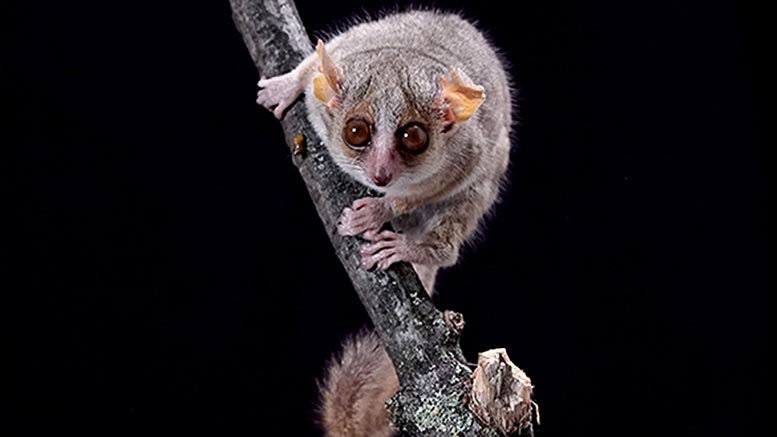The gray mouse lemur, the smallest species of primate, has excellent vision. More than a fifth of its cerebral cortex is devoted to visual processing to accommodate a sufficient number of pixel processing units. Photo credit: UNIGE / HUBER
Primates process visual information in front of their eyes, much like pixels in a digital camera, with the help of small computing units located in the visual cortex of their brain. To understand the origins of our visual abilities, scientists from the University of Geneva (UNIGE), in collaboration with the Max Planck Institute in Göttingen and the National Museum of Natural History in Paris, have examined whether these arithmetic units scale across the large size differences between primates.
The gray mouse lemur (Microcebus Murinus) from Madagascar is one of the smallest and weighs barely 60 grams. In a study published in the journal Current biologyThe scientists compared the mouse lemur’s visual system to that of other primates and found that the size of these visual processing units is the same in all primates regardless of body size. Since the mouse lemur is a very special species and shares many traits with the very first primates that evolved 55 million years ago, these results suggest an incredible preservation of our visual system and underscore the importance of sight in our daily lives and ours Ancestors in the distant past.
The visual system of primates has been studied extensively for more than a century. These studies found that, unlike other mammals such as rodents, visual information is processed by small, dedicated computing units in the visual cortex. “Since the different primate species cover a wide range of sizes, we asked ourselves whether this basic arithmetic unit scales with body or brain size. For example, will it be simplified or miniaturized for the smallest primate in the world, the gray mouse lemur? “Asks Daniel Huber, Professor in the Department of Basic Neurosciences of the UNIGE Faculty of Medicine.
Don’t worry about the size
To answer this question, the visual system of the mouse lemur was examined using an optical brain imaging technique. The lemurs were presented with geometric shapes representing lines of different orientations, and the activity of neurons that responded to the visual stimuli was mapped. The repetition of such measurements gradually allowed them to determine the size of the minimum processing unit. “We expected that a tiny unit would be proportional to the small size of the mouse lemur, but our data showed that they were more than half a millimeter in diameter,” says Daniel Huber.
In collaboration with the Max Planck researchers, Huber compared hundreds of these units, which were depicted in the tiny mouse lemur brain, with the data obtained for the visual circuits of other, much larger primate species. The team made a surprising discovery: Not only was the size of the basic processing unit almost identical in the 60-gram mouse lemur to that of larger monkeys such as macaques weighing around seven kilograms or even larger primates like humans.
They also found that the way the units were arranged in the brain was completely indistinguishable, following the same rules with mathematical precision. The researchers also found that the number of nerve cells per visual unit was almost identical in all of the primates studied so far.
The Göttingen Max Planck physicist Fred Wolf, who pointed out ten years ago that universal mathematical principles could determine the evolution of the visual system, is amazed at the degree of invariance: “55 million years of separation on different continents is a very long one evolutionary way. I would have expected a mixture of general similarity and characteristic differences between species in these neural modules. But the fact is simple: it is practically impossible to tell them apart. ”
The visual circuits are powerful and incompressible
These results provide insights into the origins of primate sight. First, the fact that this unit is so well preserved suggests that it likely evolved very early in primate history, suggesting that our primate ancestors had visual abilities similar to ours from the start.
Second, the discovery of UNIGE scientists and their staff shows that this part of the visual system cannot be compressed or miniaturized. A fixed number of neurons therefore appears to be required to ensure their optimal functionality. “In the case of tiny primate species with excellent eyesight, such as the mouse lemur, the visual system must be relatively large compared to the size of their entire brain in order to be able to accommodate a sufficient number of visual processing units,” says the Geneva-based neuroscientist. In fact, more than a fifth of this maki’s cerebral cortex is devoted to visual processing. In comparison, the neural circuits associated with vision make up barely 3% of the human brain.
“This study also underscores the critical importance of maintaining the habitat of primate species such as the mouse lemur, particularly in Madagascar’s forests. These habitats are disappearing at an alarming rate and are taking with them valuable keys to understanding our own origins, ”concludes Daniel Huber.
Reference: “Orientation preference maps in Microcebus murinus reveal size-invariant design principles in the visual cortex of primates” by Chun Lum Andy Ho, Robert Zimmermann, Juan Daniel Flórez Weidinger, Mario Prsa, Manuel Schottdorf, Sam Merlin, Tsuyoshi Okamoto, Koji Ikezoe, Fabien Pifferi, Fabienne Aujard , Alessandra Angelucci, Fred Wolf and Daniel Huber, December 3, 2020, Current biology.
DOI: 10.1016 / j.cub.2020.11.027



